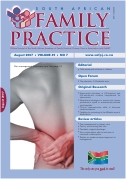Pain management in primary care – current perspectives
Abstract
According to a 1998 World Health Organization Survey of 26 000 primary care patients on five continents, 22% reported persistent pain over the past year. Part of the problem lies with some health-care providers who have failed to keep up with the advances in pain medicine and continue to follow the biomedical approach, which regards a specific pathway as the only source of pain. In this model, all pain is regarded as a warning signal of tissue injury, and if conservative treatment fails, some surgical technique will be able to correct the problem. The modern paradigm of pain management has moved from this biomedical to the broader biopsychosocial approach, where pain mechanisms now integrate input from sensory, emotional and cognitive systems.
Section
CPD
By submitting manuscripts to SAFP, authors of original articles are assigning copyright to the South African Academy of Family Physicians. Copyright of review articles are assigned to the Publisher, Medpharm Publications (Pty) Ltd, unless otherwise specified. Authors may use their own work after publication without written permission, provided they acknowledge the original source. Individuals and academic institutions may freely copy and distribute articles published in SAFP for educational and research purposes without obtaining permission.

